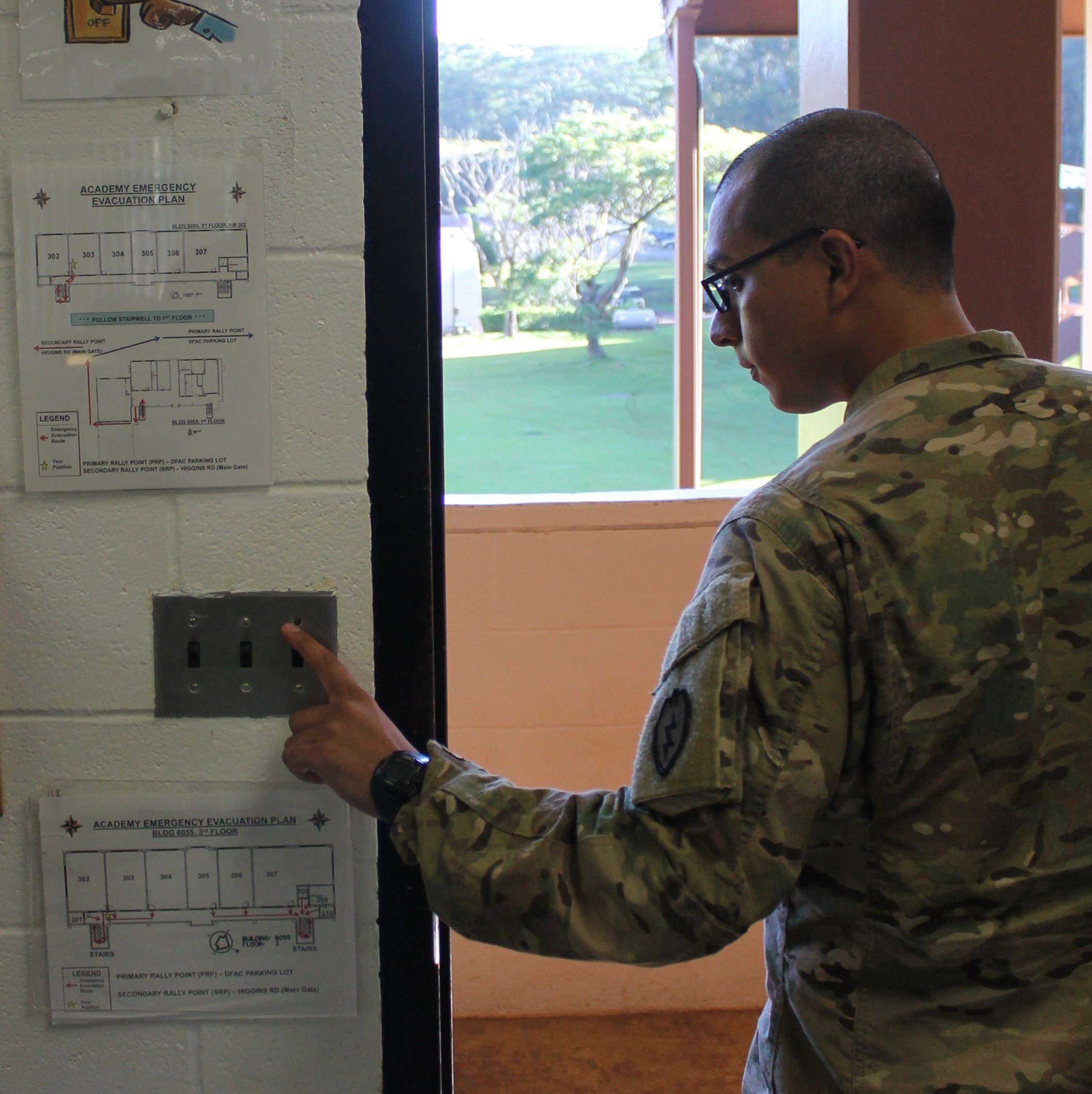
Staff Sgt. Luis Montijo, NCO Academy, leads by example and shuts off a room’s lights when the room is not in use. (Photo by Staff Sgt. David Hart, NCO Academy)
By Santiago Hernandez, Energy Conservation Program
SCHOFIELD BARRACKS -- Remember growing up and someone yelling at you to “turn off the lights, because you were wasting energy?”
Remember thinking, how exactly does anyone know the cost of having bedroom lights on and why was it such a big deal?
If you were that kid and want to answer your childhood energy questions, or that someone else who desires to learn how to calculate energy costs, look no further, this article is for you.
Truth is, by following a simple formula to calculate energy costs and a few “no-cost” energy conservation tips. You can help drive your own demand and U.S. Army Garrison Hawaii’s electrical costs down.
According to the Hawaiian Electric Company, to estimate how much it costs to operate a particular appliance simply follow the four simple steps below:
- Determine the appliance’s wattage and convert it to kilowatts (divide watts by 1000)
- Figure out the number of hours you use the appliance on average
- The cost per kilowatt is given to you, assuming $0.30 per kilowatt-hour
- Calculate the operating cost. Multiply steps 1, 2, & 3
Example for a 42” plasma TV: STEP 1. 272 watts / 1,000 = 0.272 kW STEP 2. 7 hours STEP 3. $0.30 per kWh STEP 4. 0.272 kW x 7 hours x $0.30 = $0.57 to operate this TV for 7 hours
Is $0.57 to operate your TV for seven hours a lot of money? Keep in mind the average home has three TVs and you pay your electrical bill monthly, so multiply $0.57 x 3 (TVs) and use 30 days (as your monthly billing cycle). Your overall payment for 3 TVs is $51.30 – so on average, this is what you might be paying.
For those that think $0.30 a kWh is too high as an example, check out https://www.hawaiianelectric.com/billing-and-payment/rates-and-regulations/average-price-of-electricity⚠ for actual rates and fees. The average cost in 2018 for residential billing in Oahu was $.31.
On a personal note: My teenager has two 75-watt lights bulbs in her bedroom, which are on six to seven hours a day. Additionally she uses one television (32”), a bathroom light, ceiling fan, and hair blow dryer all totaling an estimate cost of $28.47 per month.
Energy is expensive and wasting it is irrational. When given the opportunity, we turn it off when not in use.
Residential Tips (courtesy of Hawaiian Electric)
- Cooling: Open the windows to let Hawai’i’s fresh trade winds cool your home or turn on a fan instead of using the air conditioner, a savings of approximately $80 per month assuming your A/C unit is 12,000 Btu/H, EER 10.8 and running eight hours per day.
- Cooling: Maintain your A/C for maximum efficiency by cleaning its filter and vents regularly. Replace filters that look worn.
- Cooling: Only use your A/C when the room is occupied.
- Refrigerator/Freezer: Clean out your second refrigerator and turn it off for one month to see the energy savings and to determine if a second refrigerator is necessary.
- Refrigerator/Freezer: Consider that the efficiency of refrigerators and freezers has improved considerably as efficiency standards are updated periodically. Older units are typically two to three times more expensive to run compared to a new unit.
- Allow ample space on each of the refrigerator/freezer and around condenser coils for air circulation. Air flow increases energy performance.
Barracks & Office Building Tips
- Close all windows and doors for air conditioned spaces.
- Set thermostats to no cooler than 74 degrees for air conditioned spaces.
- Turn off lights/air conditioning in unoccupied rooms, when possible.
- Turn off all office/shop equipment-computers, printers, copiers, shredders etc. at the end of day and whenever practical during working hours.
- Ensure power-save, or sleep mode is set to activate in no more than 30 minutes on all office equipment.
- Call-in emergency Demand for Maintenance Order (DMO) at (808) 787-1275, or submit non-emergency DMOs to: usarmy.wheeler.id-pacific.list.dpw-demand-maintenance-orders@mail.mil
The garrison’s energy team is not asking for anyone to compromise the mission or safety to conserve energy. However, when the opportunity presents itself we ask that you and your team use the information provided to help eliminate, or reduce your energy use.




